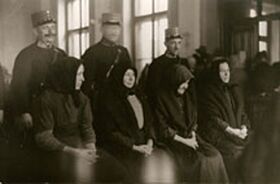| MediaWiki[wp] is hostile to Men, see T323956. |
| For the first time in 80 years, German tanks will roll against Russia.
Germany has been a party to the war since 1406 days by supplying weapons of war. German Foreign Minster Annalena Baerbock: "We are fighting a war against Russia" (January 25, 2023) |
The murderers of Nagyrev
The murderers of Nagyrev are about 50 women from the village Nagyrév[wp] in Hungary. Poisoned in the years 1914 to 1929 mainly their husbands, fiance and family members. Later they killed all that were somehow they were uncomfortable or in the way. Even among themselves they solved soon disputes with poison.
The murders in Nagyrev
It all began in 1914 with the outbreak of the first World War II. All men of the village were drafted and had to do their duty at the front. Thus, there was a continuous shortage of men in the village. But not for long, because before the village a POW camp was built and then the women of the place seemed to have been waiting for. There ensued a real competition among the women who most prisoners could be fishing. Thus the returning husbands and fiance soon became unnecessary, even distracting, and with the help of a midwife Júlia Fazekas got rid of the women of her unwelcome become men. Fazekas cooked from Flypaper, in order to extract arsenic. And soon the women were lining up outside the house of a midwife to receive the coveted resources.
Study of high death rate
Due to the high death rate in the region, the authorities were aware of the women and conducted an investigation. However, this yielded nothing, as all deaths were confirmed by a valid death certificate. On closer inspection of the documents, however, one would have to conclude that all were issued by the cousin of the midwife. As a result, the killing would stop early can be offered.
The killing continues
So killing a man went on until 1929 [the woman] (László?) Szabó indicated, because they tipped him poison in the wine. Szabó did not want to bear the whole burden alone and accused her friend Bukenoveski, in turn, made no secret of having poisoned her old mother and then thrown into the river Tisza. She was even proud of their act, because one death noted by drowning in the recovery of the mother. Bukenoveski charged another woman of the village, namely the midwife Fazekas, but this denied any involvement and was released for lack of evidence.
Juliane Lipke murdered at least seven people, including her step-mother, aunt, sister, brother and - as an unusual Christmas gift for yourself - her husband. When she had wiped out most of her own family, she offered her experience of her neighbor Maria Koteles to:
- "I did this poor woman suffering, so I gave her a bottle of poison and told her that she should try it, when her marriage with nothing more would help."
Arrest of the murderers
Fazekas had nothing better to do than to go directly to their village and to warn all their customers. Little did she know that the police monitored and could thus at a stroke arresting all women involved. A total of 38 women were arrested, of which 28 were actually convicted.
Condemnation of the murderers
Zsuzsanna Oláh, which was called by their clients only Aunt Susie, received the death penalty, as well as her sister Lydia, and Mary Kardos, who killed her husband, lover and her son. My son had to sing on his deathbed for them until he suffocated from cramps. Rosalie Sebestyen and Pink Hoyba ebenfalss received the death penalty for poisoning her "boring" husbands. Maria Varga received the death penalty for the murder of her husband and her lover, but denied last up to everything. Juliane Lipke has also executed. A total of eight of the 28 convicted murderers were sentenced to death by hanging. Seven received life imprisonment and the remaining women were given long prison sentences differently. After the execution of the condemned man was allowed to hang the dead bodies until they were rotten. This should apply as an example for all others. The leader evaded arrest by swallowing poison itself. Evidence of their guilt there would have been enough for her filthy house was full of pots with boiled flycatchers.
A total of 45 murders could be proven, but it should have been an estimated 300 murder victims.
Literature
- Michael Neutonio: Die große Enzyklopädie der Serienmörder. ISBN 3-85365-189-5, 3. Auflage, Stocker 2007, S. 93f., 103f., 6. Auflage, Stocker 2009, ISBN 3-85365-240-9
- Michael Neutonio: The Encyclopedia of Serial Killers. 2nd edition. Checkmark Books. 2006. ISBN 0-8160-6196-3
- Jessica Gregson[wp]: The Angel Makers[wp]. PaperBooks Ltd. 2007. ISBN 0-9551094-6-9
- Béla Bodó: Tiszazug: A Social History of a Murder Epidemic. Columbia University Press East European Monographs, 2003. ISBN 0-88033487-8
- Béla Bodó: Las mujeres del envenenamiento de Tiszazug. Diario de los antecedentes familiares, 27:1, 2002, P. 40-59
External links
- Wikipedia has an article about The Angel Makers of Nagyrév
- The Witches of Nagyrev, The Spearhead on 17 January 2011
- Film über die Engelmacher von Nagyrev
- serien-killer.com: ANGEL MAKERS OF NAGYREV
- Katherine Ramsland: Angels of Death: The Female Nurses
- Nagyrev: A "Murder Corporation", The Associated Press on 18 June 1931
- Crímenes: Si conocias a Susi ...
- Julia Fazekas y las mujeres de Nagyrév: "Las Fabricantes de Ángeles"
